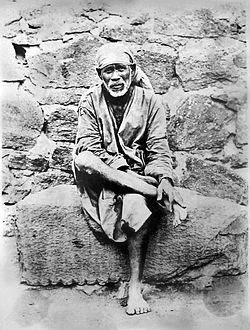Sai Baba of Shirdi
From Wikipedia, the free encyclopedia
"Shri Sai Nath" redirects here. For other uses, see Sai (disambiguation) and Nath (disambiguation).
For other uses, see Sai Baba.
| Sai Baba of Shirdi | |
|---|---|

Photograph of Sai Baba (c. 1915)
| |
| Born | 28 September 1835 Pathri, Maharashtra, India |
| Died | 15 October 1918 (aged 83) Shirdi, Maharashtra, India |
| Nationality | Indian |
| Guru | Venkusaa |
| Philosophy | Bhakti Yoga, Jnana Yoga,Karma Yoga, Self-Realization[1] |
| Notable disciple(s) | Mhalsapati, Madhav Rao (shama), Nanasaheb Chandorkar, Tatya Patil, Kakasaheb Dixit, Hemadpant, Bhuti, Das Ganu, Lakshmi Bai, Nanavali, Upasni Maharaj, Abdul Baba |
| Quotation | Shraddha - Saburi (faith - patience) |
Sai Baba of Shirdi (28 September 1835 – 15 October 1918; resided in Shirdi), also known as Shirdi Sai Baba, was an Indian spiritual master who was and is regarded by his devotees as a saint, fakir, and satguru, according to their individual proclivities and beliefs. He was revered by both his Hindu and Muslim devotees, and during, as well as after, his life it remained uncertain if he was a Hindu or a Muslim himself. This however was of no consequence to Sai Baba himself. Sai Baba stressed the importance of surrender to the guidance of the true Satguru or Murshid, who, having gone the path to divine consciousness himself, will lead the disciple through the jungle of spiritual training.
Sai Baba is worshipped by people around the world. He had no love for perishable things and his sole concern was self-realization. He taught a moral code of love, forgiveness, helping others, charity, contentment, inner peace, and devotion to God and guru. He gave no distinction based on religion or caste. Sai Baba's teaching combined elements of Hinduism and Islam: he gave the Hindu name Dwarakamayi to the mosque he lived in, practised Muslim rituals, taught using words and figures that drew from both traditions, and was buried in Shirdi. One of his well known epigrams, "Sabka Malik Ek" ("One God governs all"), is associated withHinduism, Islam and Sufism. He also said, "Trust in me and your prayer shall be answered". He always uttered "Allah Malik" ("God is King").
| Part of a series on | ||
| Hindu philosophy | ||
|---|---|---|
 | ||
| Orthodox | ||
| Heterodox | ||
Contents
[hide]Background[edit]
No verifiable information is given regarding Sai Baba's real name, place or time of birth. When asked about his past, he often gave elusive responses. The name "Sai" was given to him upon his arrival at Shirdi, a town in the west Indian state of Maharashtra. Mahalsapati, a local temple priest, recognised him as a Muslimsaint and greeted him with the words 'Ya Sai!', meaning 'Welcome Sai!'. Sai or Sayi is a Persian title given to Sufi saints, meaning 'poor one' and in Banjara language, "sayi" means good one.[citation needed] The honorific "Baba" means "father; grandfather; old man; sir" in most Indian and Middle Eastern languages. Thus Sai Baba denotes "holy father", "saintly father" or "poor old man".[2]Alternatively, the Sindhi and Urdu word "sāī.n" (سائیں), an honorific title for a virtuoso, a saint, or a feudal lord (i.e. a patron), is derived from the Persian word "sāyeh", which literally means "shadow" but figuratively refers to patronage or protection. The Hindi-Urdu word "sāyā" comes from the same borrowing. Thus, it could also mean "Master Father." However, Sāī may also be an acronym of the Sanskritterm "Sakshat Eshwar", a reference to God. Sakshat means "incarnate" and Eshwar means "God".Some of Sai Baba's disciples became famous as spiritual figures and saints, such as Mahalsapati, a priest of the Khandobatemple in Shirdi, and Upasni Maharaj. He was revered by other saints, such as Saint Bidkar Maharaj, Saint Gangagir, Saint Janakidas Maharaj, and Sati Godavari Mataji.[6][7] Sai Baba referred to several saints as 'my brothers', especially the disciples of Swami Samartha of Akkalkot.
Early years[edit]
According to the book Sai Satcharita, Sai Baba arrived at the village ofShirdi in the Ahmednagar District of Maharashtra, British India, when he was about 16 years old. He led an ascetic life, sitting motionless under aneem tree and meditating while sitting in an asana. The Shri Sai Satcharita recounts the reaction of the villagers:







No comments:
Post a Comment